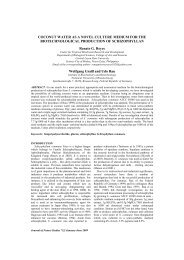Downstream processing of mannosylerythritol lipids produced by ...
Downstream processing of mannosylerythritol lipids produced by ...
Downstream processing of mannosylerythritol lipids produced by ...
Create successful ePaper yourself
Turn your PDF publications into a flip-book with our unique Google optimized e-Paper software.
Eur. J. Lipid Sci. Technol. 107 (2005) 373–380 <strong>Downstream</strong> MEL 375<br />
3 Results<br />
3.1 Bioreactor cultivation<br />
A representative example <strong>of</strong> bioreactor cultivation for the<br />
production <strong>of</strong> MEL using Pseudozyma aphidis<br />
DSM 14930 is shown in Fig. 2. After about 1 d, nitrate<br />
and yeast extract as nitrogen sources were consumed,<br />
and the course <strong>of</strong> cell protein indicated the approach to<br />
the stationary phase. However, bio dry mass continued<br />
to increase due to the accumulation <strong>of</strong> storage material<br />
inside the cells. After growth had ceased, the formation<br />
<strong>of</strong> foam cumulatively increased; therefore, impeller<br />
speed and aeration rate had to be reduced gradually<br />
from 300 to 250 rpm and from 720 to 100 L h 21 , respectively.<br />
In spite <strong>of</strong> these modifications, the pO 2 was not<br />
influenced essentially and remained at about 60%. The<br />
reduction <strong>of</strong> impeller speed and aeration rate was not<br />
sufficient to prevent overfoaming. For this reason, soy-<br />
bean oil was additionally fed in various rates, both as<br />
carbon source and as anti-foam agent. Depending on<br />
the addition and consumption rate, different amounts <strong>of</strong><br />
soybean oil and fatty acids, released from soybean oil <strong>by</strong><br />
the lipolytic activity <strong>of</strong> P. aphidis, were detected. However,<br />
repeated cultivations showed that after soybean oil<br />
addition was stopped, a prolongation <strong>of</strong> the cultivation<br />
time <strong>by</strong> 1 d was sufficient for the total assimilation <strong>of</strong><br />
residual substrates.<br />
After 3 d, the first green to yellow MEL beads separated at<br />
the bottom <strong>of</strong> the sampling bottle. The number and width<br />
(2–10 mm) <strong>of</strong> these beads increased with time. Previous<br />
investigations [18] showed that the MEL beads were<br />
formed at a concentration greater than 40 g MEL L 21 and<br />
contained high quantities <strong>of</strong> MEL .60% (wt-%) and relatively<br />
small amounts <strong>of</strong> soybean oil ,20% (wt-%) as well<br />
as fatty acids ,10% (wt-%). After 8 d <strong>of</strong> cultivation, 90 g<br />
MEL L 21 was yielded.<br />
Fig. 2. Cultivation <strong>of</strong> P. aphidis in a 30-L<br />
bioreactor. After 1 d, the impeller speed and<br />
aeration rate were gradually decreased<br />
from 300 to 250 rpm and from 720 to<br />
100 L h 21 , respectively, depending on the<br />
foam formation. Between days 2.5 and 8,<br />
soybean oil was fed at various rates (0.2–<br />
0.67 g L 21 h 21 ). The first MEL beads were<br />
observed after 3 d.<br />
© 2005 WILEY-VCH Verlag GmbH & Co. KGaA, Weinheim www.ejlst.de



